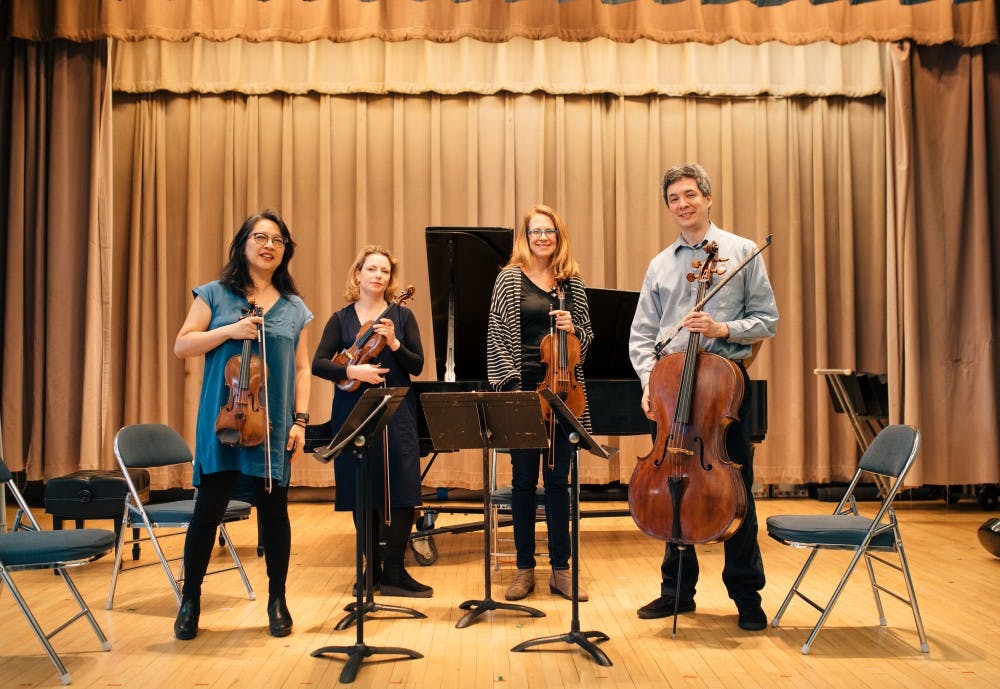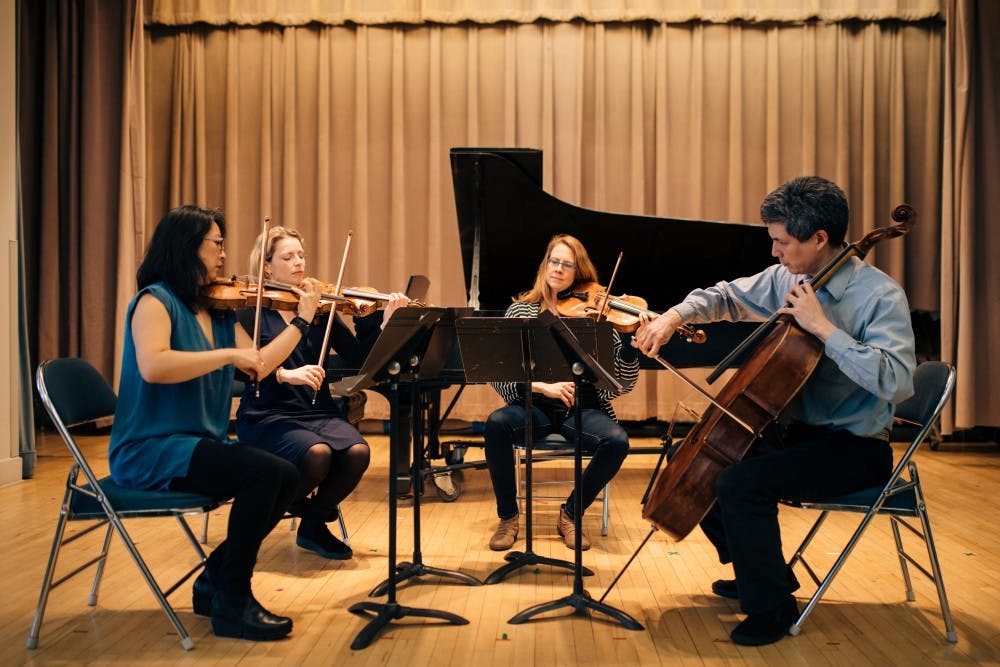Four professional musicians sit in the fourth floor of Fisher Bennett Hall, tapping their feet to the music they’re playing together. The violinist, violist, and cellist are used to playing together. They’re used to having a second violinist as well, but today she isn’t here, and an oboist is visiting from New York. They have three hours to finish rehearsing an oboe quartet for their concert in the ARCH building.
While they sit in a semicircle in the front of the room, the blackboard behind them is still covered with colorful calculus equations from the class before. After a sudden break in the music, the violinist turns to the violist and blurts out: “Is your family upset about Duke?” The violist replies: “Yeah, my 9–year–old was running away with the bracket before that happened.”
Their banter comes from years of making music together. First violinist Min–Young Kim, second violinist Matilda Kaul, violist Jessica Thompson, and cellist Thomas Kraines make up the Daedalus Quartet, the Quartet–in–Residence at Penn. The group periodically performs at venues around campus, works with student performers, and visits classes at Penn to discuss music theory.
The four are world–class musicians who perform internationally, but are also part of the Penn community. The Quartet has played in Carnegie Hall and the lobby of Rodin. They have played the complete Beethoven Quartets and student compositions from MUSC–278.
The Daedalus Quartet was formed in 2000, and the group has had a residency at Penn since Fall 2006. This is rare: few research universities have a resident string quartet, especially if they, like Penn, don’t offer a performance degree. It almost seems counterintuitive. But Matilda sees the merits: “it gives you the freedom to define your role as something much closer to what you represent in a regular society.” Being outside of the bubble of musicians makes her think about what she can bring to the community at large.
Min, Jessica, and Tom rehearse with the visiting oboist in Rose Recital Hall. They seem a bit nervous. I have been warned about this: “When you add a fifth person, we behave differently,” Matilda had said. “Oh, I was thinking that might be sort of a saving grace,” said Tom. Matilda had let out a hearty chuckle. There’s a different vibe at the rehearsal now, perhaps because the visiting oboist is here, but also because Matilda, with all her joyous energy, is missing.
When they start playing all at once, it’s like the beginning of a dramatic movie montage: all the sounds in the room spring into motion. Min’s high violin notes scream out while Tom’s cello pizzicatos climb up little by little. Jessica joins Tom to take a big bow stroke. Min leans forward and stares at her music. Everyone stops at the same time, even though no one has said anything.
“Can we start from the pickup to [measure] 75?” Min says. “I did that totally wrong.”
They all furrow their brows in the same way they scribble on their sheet music. They all wear their wedding rings on their right hands.
“Does what I’m doing seem okay?” Min asks. “Should it be more or less?”
“It was fine,” Tom says.
They go again.
To many in the Penn community, the Daedalus Quartet brings a rare experience of live classical music. Jessica loves performing for students who have little background in music and may be taking introductory music courses to fulfill the College’s Formal Reasoning requirement. “Reaching students in classes like MUSC–070 is so cool. For many of them, that might be their first experience with a live string quartet,” she says.
Tom gets excited for the opportunity to blow students away by exposing them to new types of music. He typically performs for very informed audience members who frequent classical concerts, so playing for people who aren’t used to that scene is refreshing.
Min remembers visiting GRMN–010 “Translating Cultures” to play Beethoven’s late string quartets. “There was one student who was visibly crying,” she says. “That’s why we do this. I know that feeling because it’s made me cry too. It’s just a shared experience, and it’s something that’s great about music.”
Their relationship with Penn gives them more creative freedom, too. “We get to choose music that we are genuinely artistically interested in without regard for the marketplace,” Matilda says. Not having to persuade a board of people helps them present material that they believe in. This upcoming season, they’re planning a project on the topic of migration.
Being at a research university as opposed to a music school means that they can take an interdisciplinary approach to their performances, too. “The kinds of connections we got to make here with writers, the theatre department, and the medical school changed the way that we hear those pieces and think about them,” Jessica says.
“It’s hard to replicate that in a 10–day residency because you just don’t have this kind of collegial relationship to lean on,” Matilda chimes in. “So that makes this kind of a unique place.”

Jessica starts to explain the work they did with the medical school: “We shared it with a professor in the school of otor—” Tom chimes in: “otorhinolaryngology.” Min explains: “Ear, nose, and throat.” Back to Jessica: “He talked about Beethoven dealing with his deafness in terms of hearing and perception, but also about how an audience cognitively processes music.”
“A lot of times, performing quartets have a residency in a music school and are focused on training up–and–coming quartets, which is important, but that’s not so much what we’re doing here,” Min says. “We love having access to all the great things that a top–notch research university can offer us, so we reach out to different scholars and different disciplines to collaborate and see our music with a new perspective.”
Some fascinating projects have been born out of these collaborations. The Quartet has performed in the Arthur Ross Gallery alongside actors from the theatre department who read from the diaries of Leo and Sofia Tolstoy. They also performed at Kelly Writers House and had poets write and read poetry in response to their music (a retrospective of the performance can be viewed here). “It’s certainly changed my image of the piece,” Tom says. “We’ll always hear [the poems] now.” It’s one of Jessica’s favorite memories from being in the Quartet.
Tom’s favorite collaboration was with Penn professor emeritus George H. Crumb. The group performed his electric quartet, “Black Angels,” at the Chinese Rotunda in the Penn Museum. The piece had them rubbing their bows on wine glasses pitched with water. The setup was as experimental as the piece: while running extension cords for their amplifiers, they accidentally created a radio signal. Tom says that when they finally figured it out, “there was something very cathartic about getting up and playing the piece, even though there was a very loud helicopter at a very significant part.”
The Daedalus Quartet has collaborators beyond Penn as well. Last year—when they were doing a cycle of the complete Beethoven Quartets—they worked with playwright Michael Hollinger. After a semi–stage reading of Opus, Hollinger’s play about a string quartet learning to play Beethoven’s Opus 131, the Daedalus Quartet played the same piece. “When we played Opus 131 after that,” Min says, “it just was a very different experience from any other time I played that piece.” Jessica agrees: “[the audience was] in on our process.”
When they’re not working on big projects, the Quartet mentors student musicians at Penn. Two years ago, Tom started a weekly improvisational workshop for students. “When you’re there and the audience is there, everything that happens is part of the music,” says Tom.
Saagar Asnani (C ‘19) was one of the students in the workshop. “[Improvisation] really opens your mind and your ears because you're listening to what people are doing,” he says. A violist, Saagar is also in a string quartet, so he knows about the challenges of playing with other people. “A quartet is like a weird marriage of four people,” he says.
As Min plays in Rose Recital Hall, she bounces using her entire torso. Jessica moves more from her shoulders. Tom can’t move as much with his cello, but when he does, his movements add that much more to the performance. As they reach the highest note, they all breathe in, and on the top of her breath, Jessica glances over at Min, who’s closing her eyes in concentration.
Everyone pauses and lunges forward to look at their music. “That was good,” Tom says to Min. “Was that not what I was doing before?” she asks. “No, something else happened,” Jessica says.
They go again.
Julie Cohen (C ‘19) attended a masterclass led by the Daedalus Quartet as part of MUSC–236, “Performance, Analysis, and History.” The Quartet listened to students play through a piece and offered them feedback and tips. “They have this sort of intuition where they could find things that the untrained ear wouldn’t pick out,” Julie says, “and it would totally change the feel of what was happening.”
She had an opportunity to work with them again in MUSC–278, “Composition for Musicians.” For their final projects, students had to compose for a string quartet. On the last day of class, the Quartet came in and played their pieces. Julie remembers that they were good at adapting to different styles. Jeffrey Cheng (E, W ‘19), who was also in the class, says, “I don’t think you could have picked eight pieces that were more separated by influence and by direction, and they slaughtered all of them.”
The Quartet took the students’ work seriously, and asked the students about their musical intentions. For example, Matilda would ask whether a student wanted a note in one bow stroke or multiple. “They would ask, ‘What does the name mean?’ ‘What are these tempo markings?’” Jeffrey says. “They asked about some of the articulations I put in, which were meant to resemble hammering. So they’re very perceptive.”

“They also showed crazy skill with sight reading,” Julie says. By their second performance, everything was perfect. “I was like, ‘How are you doing all these tempo shifts exactly in sync? Do you feel 56 beats per minute in your bone?’” Jeffrey says.
Julie appreciates how nonjudgmental the Quartet is. “You would expect musicians of that caliber to be kind of haughty and know–it–all, but it was not like that at all,” she says. Tom would always come up to her and tell her she was doing such a great job, and she could feel that he was being genuine. “It just felt so good to hear that from people who are so accomplished. As an insecure musician, that means a lot.”
“The Penn community has ownership of us, if you want,” Matilda says. “In ways that maybe they don’t all realize, but they own this music.”
I can feel the instrumental sounds vibrating beneath my shoes. As the movement closes, Min swooshes her bow into the air, triumphant. Tom smiles—“better,” he says. They agree that they’re done rehearsing this movement.
“And there’s this whole other piece, too,” Min says.
“Oh my god,” Jessica says.
“Oh my god,” Tom says.
They start packing up their instruments to go to ARCH. “Can you feel the stress level?” Min asks me. “But it was good!” I say. “It’s not this piece we’re worried about,” Min responds. “The other one is like, ‘Oh my god, can we even get through this?’” Performing at ARCH is not quite the same as performing at Carnegie Hall, but the Quartet is still anxious. And that’s when I realize: they truly are a part of the Penn community.
Shinyoung Hailey Noh is a sophomore studying English and Cinema Studies from Seoul, South Korea. She is a features staff writer for Street.
